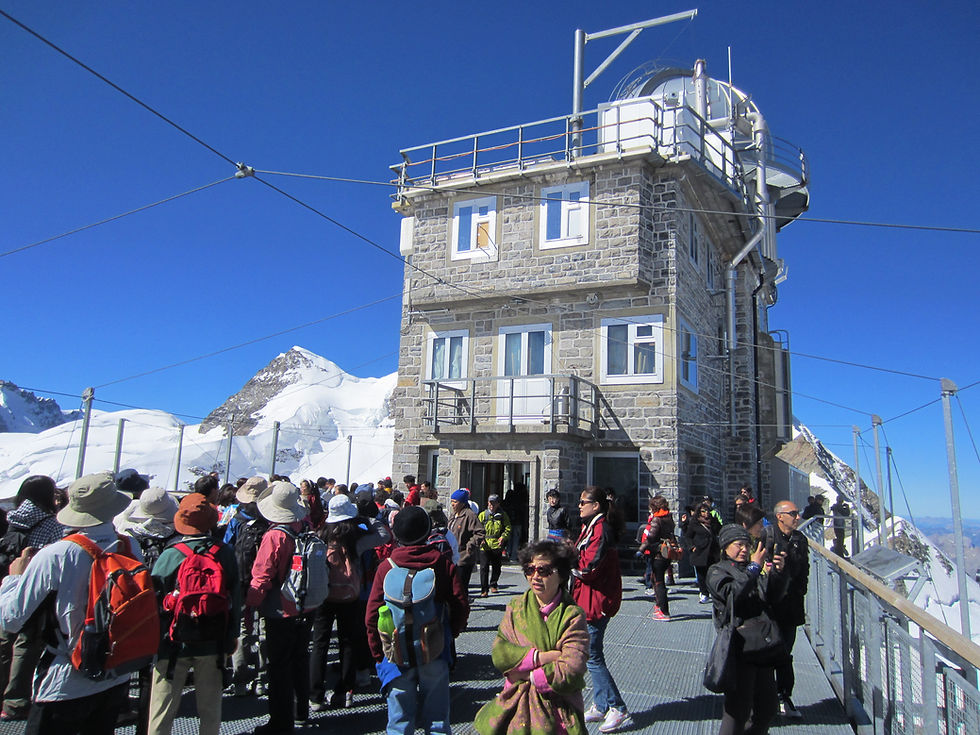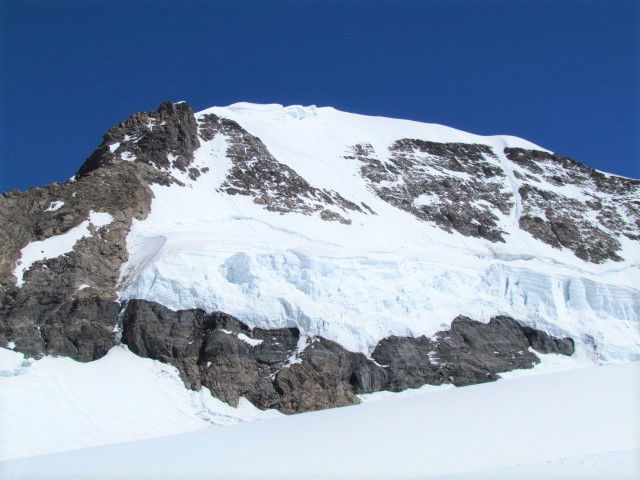Jungfrau, Switzerland
- Steve
- Aug 19, 2013
- 5 min read
Updated: Feb 3, 2021
After performing in the Edinburgh Fringe Festival, Dave and I took a side trip to Switzerland. Because there were so many activities and multiple locations, I've broken the trip into 3 separate blogs. Click on the hyperlinked text to navigate to the selected blog.
Jungfrau

Our Swiss adventure did not start out smoothly as all of our luggage was lost somewhere between Edinburgh and Bern. However, Swiss Air gave us 200 francs each to buy clothes to hold us over until our luggage was found and delivered to Wengen. So with only the clothes on our back and random items we bought in an airport store, we caught the train to Wengen.
Wengen

Wengen lies on a wind-protected sun terrace at the foot of the Jungfrau, 1,200 feet above the Lauterbrunnen valley at an altitude of 4,180 feet. The village is one of very few car-free resort villages in Europe, although there are a few local farm vehicles and electric vehicles for taxiing to and from the railway station. The village is only accessible by rail from Lauterbrunnen; it's a 14 minute ride from the valley floor to Wengen. A side note - we had the BEST chocolate croissants and apple strudel as a small bakery in Wengen.
This was the village and mountain view from our hotel room.

This was the morning view of Lauterbrunnen valley. Later in the week we spent a day walking around the valley.

Below is a view of Jungfrau from the hotel. Jungfrau is the tall mountain located in the left center portion of the picture below. It might is not the highest mountain in Switzerland but together with the Eiger and Monch, this area is one of the most stunning Swiss mountain regions.

Before we started the day, we had to buy hiking socks and rent hiking boots. Day 2 with no luggage.
Jungfraujoch
Our first destination was Jungfraujoch. It turns out that when you visit Jungfraujoch, you’re not at the summit of Jungfrau. When you look at the mountain range, you can see that Jungfraujoch is located in the saddle between these amazing peaks.

We boarded a train in Wengen for a 40 minute ride to the mountain station Kleine Scheidegg, which sits 2600 feet above Wengen. The train zigzagged up the mountainside full of beautiful green fields filled with tons of cows.

We changed trains at Kleine Scheidegg for the final leg, an amazing 50-minute ascent on the Jungfraubahn. This railway, completed in 1912, runs almost entirely within the 4.4 mile Jungfrau tunnel built into the Eiger and Mönch mountains. What a feat of Swiss engineering! The final stop Jungfraujoch - Europe's highest train station at 11,333 ft.
During the ride, we met a couple from Hong Kong who had something in common with us. We were each dressed in the same shirt as our partner! Since we had the same shirts on, the couple thought we were brothers! Although we had shopped independently in Bern, Dave and I both bought the same blue jersey. These jerseys would serve us well for the next few days.


As we exited the underground train station, we walked through a tunnel leading to an elevator that brought us to the Sphinx observatory. Originally built in 1937, the observatory has undergone a number of renovations and additions. The pictures below show the unique location of this building. How did this get built in the 1930's?


The observatory is the silver structure perched on the rock outcropping. If you look closely you can also see the tunnel which leads to the underground train station. The tunnel is located at the base of the rock face where all of the people are assembled.
In the picture below the Jungfrau summit is visible to the left of the Sphinx Observatory.

An observation deck at the Sphinx provided 360 degree view of the Great Aletsah Glacier and the snow-capped Alps. These views are the reason why Jungfraujoch appears on so many bucket lists.


A nice picture of Dave with the Mönch peak in the background. Yes, he was wearing shorts. All his pants were in the lost luggage. Fortunately, it was sunny and not too cold.
Pictured below is Great Aletsch Glacier, the largest glacier of the Alps. It is more than 13.5 miles long, has a maximum thickness of 2,500 feet and covers about 32 square miles. With an unbelievable 27 billion tons of ice, if melted, the Great Aletsch Glacier could supply every single person on the Earth with a liter of water every day for 4.5 years. However, the problem is the glacier is receding by as much as 300 feet every year.

Hike to Mönchsjochhütte
Since the weather was cooperating, we decide to complete the hike to Mönchsjochhütte, the highest-altitude service hut in Switzerland. The hut sits at 11,975 feet and is accessible on a marked footpath from Jungfraujoch. Since we weren't acclimated to the altitude, this wasn't an easy hour-long walk.




If you look closely at the picture below, you can see the party approaching the summit of this snow-capped peak.

Finally within sight of Mönchsjochhütte and almost time for a hot chocolate.

We made it, enjoyed our hot chocolate taking in the views of the beautiful Swiss Alps all around us.

I think the main summit in the picture below is the Gletscherhorn which is another of the 13,000 foot peaks in the Bernese Alps.


Soon it was time to head back to the Jungfraubahn station. Other than shortness of breath, we didn't experience any signs of altitude sickness. In the picture below, the arrow points to the Sphinx Observatory. It's amazing to ponder the effort required to build such this structure. Overall, this was such a great introduction to the Swiss Alps.

Hike Kleine Scheidegg to Wengen
Since it was still early in the day and the weather was relatively warm, we decided to hike from Kleine Scheidegg back to Wengen instead of taking the train. But first a drink and snack.

Kleine Scheidegg is a mountain pass at an elevation of 6,762 ft that is nestled directly at the foot of the Eiger North Face. With this unique location and outstanding views of the other summits, Kleine Scheidegg is among the most celebrated mountain passes in the Swiss Alps.

The views of Eiger North Face that towers over Kleine Scheidegg were breathtaking.

The Eiger is over 13,000 ft tall which in and of itself is impressive, but the most notable feature is its 5,900 ft north face of rock and ice. It is one of the three great north faces of the Alps, along with the north faces of the Matterhorn and the Grandes Jorasses (known as 'the Trilogy'). If we are lucky and the weather holds out, we'll have a chance to see the second great north face next week in Zermatt.

The north face was first climbed in 1938 by an Austrian-German expedition. Today it is regarded as a formidable challenge more because of the increased rockfall and diminishing ice-fields than because of its technical difficulties. In the picture below, you can also see Mönch to the right of Eiger.


There were a few hiking trail options to chose. However, there are no wrong decisions when you are in the Swiss Alps. I'm not sure of the mileage but we selected the 2-hour trail back to Wengen.
We reached the avalanche control fences as we got closer to Wengen,
Although this picture wasn't taken at the end of the hike, it summarized our long first day of trekking through the Swiss Alps.

















コメント